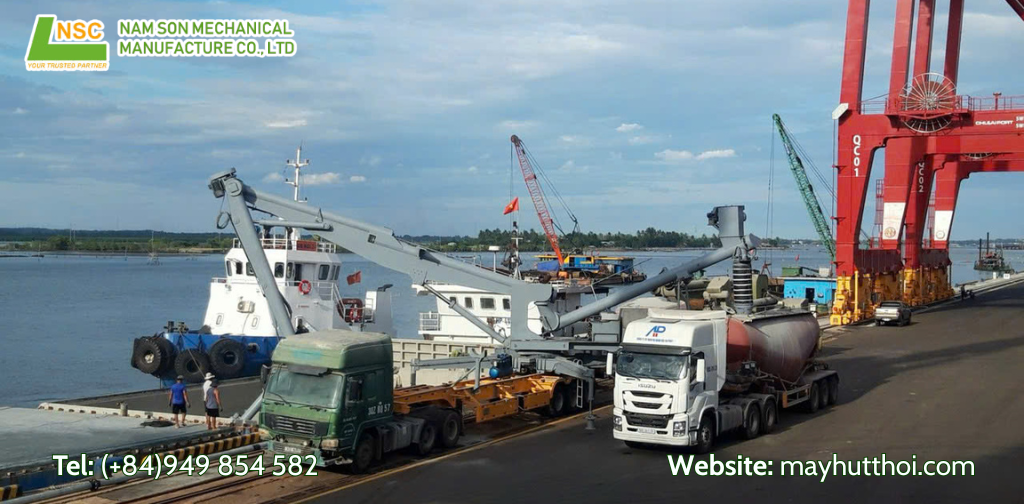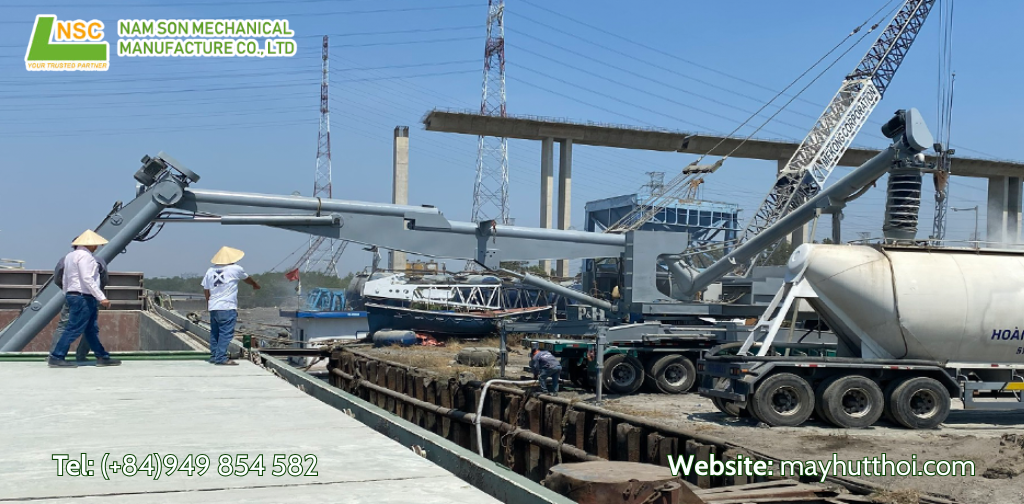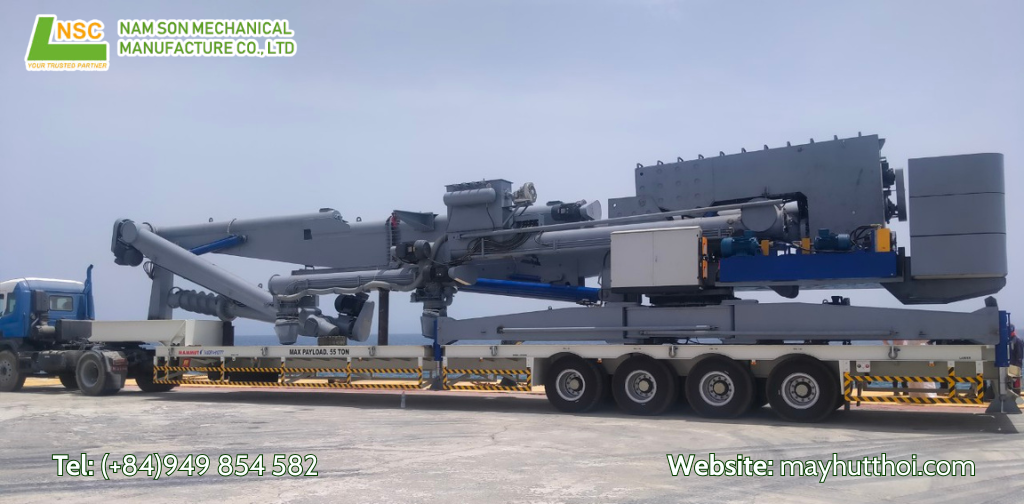Modern ports rely on efficiency. The faster a vessel is unloaded, the higher the terminal’s productivity and profitability. A
bulk ship unloader plays a key role in this process — it automates the handling of bulk materials such as cement, coal, grain, and fertilizer, replacing older manual or semi-mechanical systems. By reducing unloading time, energy use, and spillage, it directly enhances
port unloading efficiency.
What is a bulk ship unloader, and how does it work?
A
bulk ship unloader is an automated system for discharging dry bulk cargo from a vessel’s hold to onshore storage or conveying systems.
It ensures high throughput capacity, minimizes dust, and reduces operational downtime.
=>SEE MORE: What is a ship unloader? A complete guide to its function and applications
1. How a bulk ship unloader operates
When a vessel arrives, the unloader’s boom is positioned over the cargo hold. The
equipment’snozzle or
grabbing device extracts the material.
+ In a
continuous ship unloader (CSU), a chain of buckets or a screw conveyor lifts material continuously, moving it through a
belt conveyor system to silos or hoppers.
+ In a
pneumatic unloader, vacuum pumps draw in fine or powder materials like cement or grain through enclosed pipelines, reducing dust and product loss.
+
Grab unloaders, often used for coal or ore, use mechanical grabs to lift material in cycles.
The
control system synchronizes the movement of the boom, bucket, and conveyor, optimizing efficiency and preventing material overflow.
2. Core components
- Boom & slewing mechanism: Provides reach across multiple holds.
- Hopper & feeder system: Controls the material discharge rate.
- Conveyor belts: Ensure smooth material flow to onshore silos.
- Automation & safety sensors: Manage load distribution and prevent mechanical strain.
With these integrated systems, a modern
bulk cargo unloader can achieve discharge rates of 800–2,000 tons per hour, depending on cargo density and vessel type.

Key features of modern bulk ship unloaders
Today’s
bulk ship unloaders incorporate advanced technologies that directly boost
port unloading efficiency and reduce operational costs.
1. Automation and smart control
Automation replaces manual operation with real-time precision.
Advanced
PLC/SCADA systems manage the positioning, suction, and conveying process. Operators can control the unloader remotely, enhancing safety and minimizing labor dependency.
AI-based algorithms adjust
unloading speed automatically according to material density and moisture content — optimizing throughput in dynamic conditions.
2. High throughput and energy efficiency
Modern unloaders achieve higher
throughput capacity (TPH) through continuous operation and energy-efficient drives.
Variable Frequency Drives (VFDs) regulate motor speed, cutting electricity use by up to 25%. This directly
reducescostper ton handled — a crucial metric in port economics.
3. Dust suppression and environmental compliance
Ports today face strict regulations on air quality.
To comply, unloaders integrate
dust suppression systems, enclosed conveyors, and
negative-pressure pipelines to prevent particle release.
This results in cleaner docks, lower product loss, and safer working conditions — aligning with green port and
sustainable logistics goals.
4. Easy maintenance and reliability
Design improvements like
modular structure,
quick-access panels, and
self-diagnostic software minimize downtime.
Predictive maintenance via IoT sensors alerts technicians before failures occur, increasing machine availability to over 98%.
5. Integration with smart port systems
New unloaders are compatible with
digital twin technology and
port management software.
They transmit operational data (load rate, vibration, energy usage) to centralized control rooms, allowing real-time optimization of
cargo handling systems across the terminal.
How bulk ship unloaders improve port unloading efficiency
The
primary value of a bulk ship unloaderlies in transforming the way ports handle cargo — faster, safer, and more efficiently
.
1. Reduced unloading time
Traditional cranes may take up to 36 hours to unload a bulk carrier.
A
continuous ship unloader can reduce that time by up to 50%, achieving unloading speeds of 1,200–1,800 TPH depending on material type.
Faster unloading means more ship calls per berth and reduced demurrage costs.
2. Improved material flow and throughput
Continuous material transfer ensures a constant flow from the ship to the storage.
By eliminating loading pauses and reducing spillage,
bulk transfer systems achieve higher
operational efficiency and stable discharge rates — key to maximizing terminal capacity.
3. Reduced downtime and operating costs
Predictive control systems detect overloads, vibrations, or blockages early.
This reduces mechanical failures, cutting maintenance costs by up to 20%.
Automated operations also reduce manpower requirements, optimizing resource allocation.
4. Minimized spillage and environmental impact
Built-in
spillage control prevents cargo loss and contamination of port surfaces.
With integrated
dust control systems, ports can maintain compliance with ISO 14001 and MARPOL environmental standards.
5. Enhanced safety and worker conditions
Automation minimizes the need for workers inside cargo holds, drastically lowering accident risks.
Improved ergonomics and monitoring make
ship unloading operations safer and more predictable.

Application fields and future trends of bulk ship unloaders
1. Application fields
Bulk ship unloaders serve as critical equipment across multiple industries:
+ Cement terminals: Pneumatic unloaders are ideal for powdered materials, reducing dust and maintaining cement quality.
+ Coal & ore ports: Continuous or grab unloaders handle high-density cargo with superior efficiency and minimal spillage.
+ Grain handling facilities: Gentle suction systems prevent kernel breakage and contamination, ensuring food-grade quality.
+ Fertilizer terminals: Corrosion-resistant designs and enclosed conveyors prevent moisture damage and maintain product purity.
+ Dry bulk logistics hubs: Multi-purpose
unloaders allow flexible handling of various commodities, increasing terminal utilization rates.
Each application benefits from faster unloading cycles, better dust control, and reduced cargo degradation — all of which contribute to improved
port terminal efficiency.
2. Future trends
The next generation of
bulk ship unloaders is shaped by automation, sustainability, and data-driven control.
- AI-driven automation: Predictive algorithms self-adjust flow rates based on cargo type and weather conditions.
- IoT and predictive maintenance: Smart sensors provide real-time analytics on motor health, temperature, and vibration.
- Low-emission systems: Electrically driven unloaders replace diesel-powered models, cutting CO₂ emissions by 30–40%.
- Digital integration: Seamless connectivity with smart port systems allows centralized scheduling and performance tracking.
- Sustainability goals: Green technologies like energy recovery systems and dust-free pipelines support eco-friendly port development.
These innovations make
bulk ship unloaders essential for next-generation ports that aim for zero emissions, high productivity, and full automation.
=>SEE MORE: 5 common errors when operating a cement ship unloader and how to fix them

Conclusion
A bulk ship unloader is more than just machinery — it’s a key driver of
port unloading efficiency.
By combining automation, high throughput, and environmental control, it delivers measurable gains in productivity and sustainability.
Ports adopting advanced
ship discharging systems benefit from:
~ Up to 50% faster unloading times
~ Lower operating costs through automation
~ Cleaner, safer environments compliant with modern standards
As the maritime industry transitions toward
smart port technology, investing in efficient
bulk ship unloaders ensures a competitive advantage and a sustainable future for bulk logistics operations.
Looking to boost your port’s unloading efficiency? Contact our engineering team today for customized bulk ship unloader solutions that maximize throughput, minimize dust, and cut operating costs.
Get a free consultation now!Contact us
✱ Website: mayhutthoi.com|
namsonco.com✱ Alibaba: dthson.trustpass.alibaba.com✱ Facebook: facebook.com/NamSonPneumaticConveyor✱ Zalo/Whatsapp:(+84) 949854582
✱ Email: mailan@namsonco.com | thanhson@namsonco.com




 .
.
